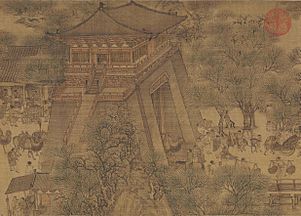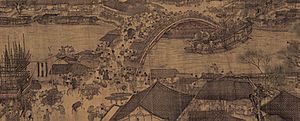Along the River During the Qingming Festival facts for kids
Quick facts for kids Along the River During the Qingming Festival |
|
|---|---|
| 清明上河圖 | |

A small section of the painting depicting scenes at the Bianjing city gate
|
|
| Artist | Zhang Zeduan |
| Year | 1085–1145 |
| Type | Ink and color on silk; handscroll |
| Dimensions | 25.5 cm × 525 cm (10.0 in × 207 in) |
| Location | Palace Museum, Beijing |
| Along the River During the Qingming Festival | |||||||||
|---|---|---|---|---|---|---|---|---|---|
| Traditional Chinese | 清明上河圖 | ||||||||
| Simplified Chinese | 清明上河图 | ||||||||
| Literal meaning | Title can be considered a literal translation; alternatively A Picture up the River at Qingming | ||||||||
|
|||||||||
Along the River During the Qingming Festival (also known as Qingming Shanghe Tu) is a famous handscroll painting. It was created by the Song dynasty artist Zhang Zeduan (who lived from 1085 to 1145). Many copies of this painting have been made over the centuries.
The painting shows the everyday life of people and the scenery of Bianjing. This was the capital city of the Northern Song dynasty, which is now called Kaifeng. The painting is thought to celebrate the lively spirit of the Qingming Festival. It focuses on the busy activities, not just the traditional parts like visiting tombs. As you unroll the painting from right to left, you see different scenes. They show how people from all parts of society lived, from the rich to the poor. You can also see economic activities in both the countryside and the city. It gives us a peek at the clothes and buildings from that time. This painting is considered one of the most famous Chinese paintings ever. Some even call it "China's Mona Lisa."
This amazing artwork has been admired for a long time. Artists in later dynasties made hundreds of copies and even fakes of good copies. Each copy followed the main idea of the original but had different details. For many years, the original Song painting was owned by private collectors. Eventually, it became public property again. China's Last Emperor, Puyi, loved this painting. He took it with him when he had to leave the Forbidden City in 1924. The painting was found in 1945. Now, it is kept at the Palace Museum in the Forbidden City. The original painting and its later versions are seen as national treasures. They are only shown for short times every few years.
Contents
The Original Song Dynasty Painting
The first version of Along the River During the Qingming Festival is a very famous artwork from the Song dynasty. We don't know much about the painter, Zhang Zeduan. Records were lost when the Jin dynasty took over the Northern Song dynasty. Experts still discuss who created it, when and where it was painted, and what its true meaning is. The earliest mention of Zhang Zeduan as the artist is from 1186. This was based on an earlier record by a Jin imperial art expert.
The painting is about 25.5 centimeters (10 inches) tall. It is also about 5.25 meters (17 feet) long. In this long painting, you can find many details. There are 814 people, 28 boats, 60 animals, and 30 buildings. You can also spot 20 vehicles, 8 sedan chairs, and 170 trees. Only about twenty women appear in the original Song painting. Most women seen outdoors are of lower social rank or are with men.
The painting has two main parts: the countryside and the busy city. A river winds through the entire artwork. The right side shows the rural area outside the city. Here, you can see crop fields and calm country people. These are mostly farmers, goat herders, and pig herders. A country path widens into a road that connects to the city road. The left side shows the urban area, which leads into the main city through its gates. This area is full of economic activity. You can see people loading goods onto boats, many shops, and even a tax office. People from all walks of life are shown. There are peddlers, jugglers, actors, and beggars. You can also see monks, fortune tellers, doctors, innkeepers, teachers, and various skilled workers.
Outside the city gate, there are all kinds of businesses. They sell wine, grain, used goods, cooking tools, and weapons. You can also find lanterns, musical instruments, gold, silver, and jewelry. Other shops sell dyed fabrics, paintings, medicine, needles, and old artifacts. There are also many restaurants. Vendors set up their stalls all along the big bridge. This bridge is called the Rainbow Bridge (Hong Qiao).
The great bridge crossing the river is the main focus of the painting. There is a lot of excitement and noise on the bridge. A boat is coming towards the bridge at a strange angle. Its mast is not fully lowered, and it looks like it might crash into the bridge. Crowds on the bridge and along the river are shouting and waving at the boat. Someone on the bridge is lowering a rope to the boat's crew. Besides shops and diners, there are inns, temples, homes, and official buildings. They range from small huts to large mansions with big yards.
People and goods are moved in many ways. There are wheeled wagons and many working animals like donkeys and mules. People also use sedan chairs and chariots. The river is full of fishing boats and ferries. Men on the river bank are pulling the larger ships. Many of these details match descriptions from other Song dynasty writings. One famous writing is the Dongjing Meng Hua Lu, which also describes life in the capital city.
Copies of the Painting
The original painting was a prized possession of the emperors for centuries. Many artists copied it in later periods. This made the painting well-known among nobles, scholars, city residents, and merchants. For a long time, many experts thought the Song original was the only "masterpiece." They didn't respect later versions, calling them just copies or fakes. More than a hundred of these copies are now in museums around the world. However, people have recently started to see the importance and value of these "copies."
An early copy, believed to be very similar to the original, was made by Zhao Mengfu during the Yuan dynasty.
The Ming dynasty (from the 14th to 17th centuries) painter Qiu Ying made several copies. These copies are quite different from the original. One version is now at the Metropolitan Museum of Art in New York City. Another copy is 6.7 meters (22 feet) long, which is longer than the original. This Ming version changed the scenery to match Ming dynasty styles and customs. It updated the clothes people wore and the types of boats and carts. The original wooden bridge was replaced with a stone bridge. The stone bridge's arch is much taller. In the original, a boat was about to crash into the bridge. In the Ming copy, a boat is calmly guided under the bridge by ropes, with other large boats waiting their turn. Another 12-meter-long copy from the late Ming period is in the Museum of Applied Arts, Vienna in Austria.
In the late Ming and early Qing dynasties, many copies were made by professional painters in Suzhou. These often had fake signatures of Zhang Zeduan or Qiu Ying. Some scholars argue that these paintings should not be seen as just "copies." They believe these artists created unique paintings. These paintings showed what people in those times thought an "ideal society" looked like.
A very different copy is the "Qing Court Version." The Yongzheng Emperor ordered this painting to be made. It was finished after his death by five court painters. These artists worked from a draft by another court painter, Shen Yuan. This draft was likely made under the emperor's direct watch. The finished painting was given to the Qianlong Emperor in 1737. This version is special because of its new style, many details, and excellent condition. This painting was later moved to the National Palace Museum in Taipei in 1949. This remake has over 4,000 people, much more than the original. It is also much larger, at 11 meters (37 feet) long and 35 centimeters (1 foot) tall. The far left part of this version shows the inside of the palace. It has elegant buildings and refined people, mostly women and well-dressed officials.
A Poem Added to a Copy
In April 1742, the Qianlong Emperor wrote a poem. It was added to the right end of the 1737 copy of the scroll. The poem was written in a flowing style by Liang Shizheng, a high-ranking official and friend of the emperor.
Famous Exhibitions
The original Song painting is rarely shown. It was displayed in Hong Kong from June to August 2007. This was to celebrate 10 years since Hong Kong became part of People's Republic of China. Shipping this priceless artwork cost millions of dollars. Insuring it also cost a lot of money.
From January 2 to 24, 2012, the painting was shown at the Tokyo National Museum. It was the main attraction of a special exhibit. This exhibit marked 40 years of good relations between China and Japan. Japanese museum officials made sure the painting had the "highest security standards."
Digital Version
For three months at the World Expo 2010 in Shanghai, a digital version of the painting was shown. It was a 3D animated and interactive version called River of Wisdom. This digital mural was huge, about 30 times the size of the original painting. It was 128 meters (420 feet) long and 6.5 meters (21 feet) tall. The computer animation brought the painting to life. Characters and objects moved, and the scene changed from day to night over 4 minutes. It was a main exhibit at the Chinese Pavilion. People waited up to two hours to see it, even with reservations.
After the Expo, the digital version was shown in Hong Kong from November 9 to 29, 2010. It was a big success. Then it traveled to Macau from March 25 to April 14, 2011. The digital painting also went to Taiwan and was shown in Taipei from July 1 to September 4, 2011. From December 7, 2011, to February 6, 2012, it was part of an exhibit in Singapore. Today, you can see it permanently at the China Art Museum in Shanghai.
Gallery
See also
 In Spanish: El festival Qingming junto al río para niños
In Spanish: El festival Qingming junto al río para niños
- Chinese painting
- Culture of the Song dynasty



